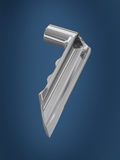Glaucoma Treatment
Understanding Glaucoma
Glaucoma has been nicknamed “the sneak thief of sight.” According to the World Health Organization, it is the second leading cause of blindness worldwide. Glaucoma cannot be cured, and vision loss cannot be regained. But with proper treatment, it is possible to slow the progression of glaucoma and potentially halt further loss of vision.
A clear fluid, called aqueous humor, fills the front of your eye and provides nourishment to the tissues. Like the air in a balloon, the aqueous also provides pressure to help maintain the shape of the eye.
In most types of glaucoma, the eye’s natural drainage system loses function and the fluid inside the eye cannot drain. This lack of drainage causes an elevation of pressure within the eye. This increase in intraocular pressure (IOP) has demonstrated the ability to exert pressure on the optic nerve and result in vision loss.
Vision loss can have a very serious impact on one’s quality of life. Many people with glaucoma cannot drive a car safely, see their grand kids on the soccer field, or view the world as they once did. The first sign of glaucoma is often the loss of peripheral or side vision. To prevent this from happening, it is essential to lower your IOP.
An Exciting New Technology For The Treatment of Glaucoma
Technology has always played an important role in eye care. Today, almost every aspect of vision is connected to a product or procedure that wasn’t available even 10 short years ago. The cataract surgery you are scheduled for is a good example of how innovations can make a difference. Every aspect of it uses recently developed technology that will help your doctor improve your vision.
Today this includes managing your glaucoma.
Now, your doctor is able to add another step to your cataract surgery that allows your glaucoma to be treated in a completely new way. This is important because once diagnosed with glaucoma, you and most patients like you will spend the rest of your lives taking one, two or even three different medication drops. Unfortunately, you will need to use these drops every day, which will not only be inconvenient, but potentially very expensive. The iSent Trabecular Micro-Bypass Stent can help with this, and you can have it done at the same time you have cataract surgery. Even so, your eye drop medication use is at the discretion of your prescriber.
iStent:
The world’s smallest medical implant delivers BIG results.
You have mild-to-moderate glaucoma. At this stage of the disease, your vision may be unaffected. But without proper treatment the pressure in your eye could increase and your optic nerve could be damaged. This pressure is caused by the buildup of fluid within your eye. Too much fluid raises pressure, which can cause gradual loss of vision. And while glaucoma moves slowly, its damage is irreparable. Once you start to lose vision, you can never get it back again.
 The world’s tiniest medical device- the iStent Trabecular Micro-Bypass Stent– is 20,000 times smaller than the intraocular lens (IOL) your doctor will use to replace your cataracts. But the size of the iStent is only part of its story. By increasing your eye’s ability to drain fluid, this technology is designed to improve the aqueous outflow to safely lower your eye pressure.
The world’s tiniest medical device- the iStent Trabecular Micro-Bypass Stent– is 20,000 times smaller than the intraocular lens (IOL) your doctor will use to replace your cataracts. But the size of the iStent is only part of its story. By increasing your eye’s ability to drain fluid, this technology is designed to improve the aqueous outflow to safely lower your eye pressure.
In a US clinical study 68% of patients who received iStent remained medication-free at 12 months, while sustaining a target IOP of <21 MM HG vs. only 50% of patients who underwent cataract surgery alone.
Manage your glaucoma
IStent works like the stents used to prevent heart attacks and strokes. When blood vessels get clogged, a stent creates access to the vessel flow.
While it’s a highly innovative technology, how iStents works is elegantly simple:
- If you have glaucoma, over time your eye’s natural drainage system becomes clogged
- IStent creates a permanent opening through the blockage to improve the eye’s natural fluid outflow
- By improving the outflow of fluid in your eye, iStent is designed to lower and control the pressure within your eye
If iStent sounds like something you’re interested in, talk to us today. We will be able to answer other questions you might have.
iStent is the smallest medical device ever approved by the FDA. It is placed in your eye during cataract surgery and is so small that you won’t be able to see or feel it after the procedure is over. iStent is designed to create a permanent opening in your trabecular meshwork, and works continuously to improve the outflow of fluid from your eyes to help control eye pressure.
For patients with combined cataract and open-angle glaucoma, iStent reduces introcular pressure (IOP) by improving aqueous humor outflow. Inserted through a 1.5-mm corneal incision, iStent is the only FDA-approved device for the treatment of mild to moderate open-angle glaucoma.
3 Convenient Locations To Better Serve You!
Bloomfield Hills
43996 Woodward Ave, Ste 101
Bloomfield Hills, MI 48302
Phone: 248-332-4544
Map & Directions
Detroit
14400 West McNichols Road
Detroit, MI 48235
Phone: 313-341-3450
Map & Directions
Westland
7992 North Wayne Road
Westland, MI 48185
Phone: 734-522-6131
Map & Directions
Canaloplasty is a new alternative for glaucoma patients.
Canaloplasty is an advanced, non-penetrating procedure designed to enhance and restore the eye’s natural drainage system to provide sustained reduction of IOP. Canaloplasty utilizes breakthrough microcatheter technology in a simple and minimally invasive procedure.
How is a canaloplasty performed?
To perform a canaloplasty, your doctor will create a tiny incision to gain access to a canal in the eye. A microcatheter will circumnavigate the canal around your iris, enlarging the main drainage channel and its smaller collector channels through the injection of a sterile, gel-like material called viscoelastic. The catheter is then removed and a suture is placed within the canal and tightened. This tightened suture ensures that the canal remains open. By opening the canal, the pressure inside your eye will be relieved.
What are the benefits of canaloplasty?
A canaloplasty procedure might be the optimal choice for patients whose medications aren’t working but aren’t quite ready to take on the risks of surgery. It may also be optimal for patients whose medications are working but are frustrated with the frequency of dosing.
Canaloplasty benefits compared to traditional glaucoma treatments
-
Less risk of post-operative complications versus penetrating surgical alternatives
-
Does not eliminate the possibility of future treatment alternatives
-
Reduced scarring
View A Video About The Canaloplasty Procedure
Burman & Zuckerbrod Ophthalmology is proud to announce “A burst of good news for those with glaucoma…”
Our practice now offers MicroPulse® P3 “Cyclophotocoagulation” There is a new type of laser treatment or minimally invasive glaucoma surgery (MIGS) that has quietly joined the fray in the battle against glaucoma: MicroPulse® P3 “Cyclophotocoagulation” (or “MP3”).
MicroPulse® P3 “Cyclophotocoagulation”
uses a slow application of laser energy that is “chopped” into micropulses (or, bursts). Each pulse heats up, but does not burn or destroy eye tissue. In between each pulse is a pause. This pause allows the eye tissue to cool off. In this manner the eye tissue is changed rather than destroyed.
In 2010 results were published documenting the beneficial effect on glaucoma that has not been controlled by any traditional methods of eye pressure reduction (drops, laser, or surgery). This type of glaucoma just does not respond well to treatment. Yet one and a half years out from MicroPulse® P3 “Cyclophotocoagulation” the patients in this study experienced an average drop in eye pressure of 33% and had (on average) reduced their medication use by almost half (2.1 to 1.3 drops)
MicroPulse technology
is a tissue-sparing solution where a continuous-wave laser beam is chopped into a train of tiny, repetitive, low energy pulses separated by a brief rest period which allows tissue to cool between laser pulses. Fortunately, as MicroPulse® P3 “Cyclophotocoagulation” is based on a procedure that has been around for decades, it is generally reimbursed by commercial insurances and Medicare without hassle. This makes it unique among minimally-invasive glaucoma surgeries (MIGS).
MicroPulse® P3 “Cyclophotocoagulation” is done while in the supine (lying on back) position. Unlike other glaucoma surgeries this procedure can be done even if someone has difficulty lying all the way back due to neck, spine, or breathing difficulty. As such, it is an ideal glaucoma surgery for those with significant medical conditions such as congestive heart failure.
Because there are no incisions (cuts) made in the eye during MicroPulse® P3 “Cyclophotocoagulation” there is no need for sterile draping of the eye. As such, MP3 glaucoma laser surgery is also a good option for anyone who is claustrophobic.
Your ophthalmologist will likely want to see you in his or her office within the first week after surgery. Your eye pressure may or may not be lower at this first post-operative visit. By one to three months after MP3, however, eye pressure lowering should be observed. If the eye pressure is still elevated then a second treatment may be necessary to achieve a reduction in eye pressure.
The combination of eye pressure lowering benefit, low risk profile, and likely reimbursement by commercial insurances and Medicare makes MicroPulse® P3 “Cyclophotocoagulation” a good option for almost all patients with glaucoma who fit into any of the following categories:
- Those with poorly controlled eye pressure despite using all available glaucoma medications
- Those who have difficulty tolerating glaucoma medications
- Those who have difficulty affording their glaucoma medications
- Those who have difficulty regularly taking their glaucoma medications
- Those who have already had other glaucoma laser treatments
- Those who are physically unable to tolerate more extensive glaucoma surgery
Given the above list, it’s apparent that almost anyone with glaucoma could benefit from MicroPulse® P3 “Cyclophotocoagulation”.
Hospital & Surgery Center Affiliations
Should you require surgery, our board certified ophthalmologists are affiliated with the following hospitals:
- St. John Health System
- Beaumont/Oakwood Health System
- Cataract Specialty Surgery Center – Berkley
- Detroit Medical Center
- LASER Institute of Michigan
- St. Joseph Mercy Hospital
Information For New Patients
Please note that a complete eye examination may take up to two hours. A trained ophthalmic tech will do a preliminary screening and take a complete health history. The examination will be done entirely by one of our board certified ophthalmologists who may recommend additional testing based on his/her findings. When you come to your appointment please remember to bring eye glasses or contact lenses if you wear them, a complete list of your current medications, the name of your physician who may have referred you to us so that we may send a prompt written report to maintain continuity of care, a driver’s license for identification purposes, all current insurance information and a referral form if applicable.
Insurance and Payments
In order to keep our costs down, payment is expected at the time that services are rendered. You will be responsible for co-pays, deductibles, and fees not covered by your insurance. We accept cash, check, VISA, Discover, American Express, and CareCredit. Our billing associates will be glad to assist you. Please note that it is your responsibility to know the terms of your insurance benefits. We are participating providers for most of the current health insurance plans.
![]()
![]()

